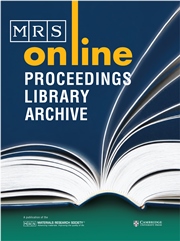No CrossRef data available.
Article contents
Current Controlled HTS Switches Fabricated by a Reactive Patterning Technique
Published online by Cambridge University Press: 26 February 2011
Abstract
A current controlled HTS switch (CCSS) has been fabricated using the Si-YBCO reactive patterning technique. The Si films were deposited on MgO substrates by e-beam evaporation and patterned via a lift-off process. The YBCO films were deposited thereafter by pulsed laser deposition to form micron-sized HTS strip lines with different widths and lengths. A typical line has a normal resistance ranging from 10 Ω to 100 KΩ. A CCSS was constructed using such a HTS line as a resistor in parallel with a load resistor. The operation of CCSS is similar to that of a current divider. Applications of CCSS includes HTS logic gates and circuit breakers.
Information
- Type
- Research Article
- Information
- Copyright
- Copyright © Materials Research Society 1992
References
REFERENCES
2.
Frenkel, A., Saffi, M. A., Venkatesan, T., Lin, C., Wu, X. D., and Inam, A., Appl. Phys. Lett.
54, p1594 (1989)Google Scholar
3.
Donaldson, W. R., Kadin, A., Ballentin, P. H., and Sobolewski, R., Appl. Phys. Lett.
54, p2470 (1989)Google Scholar
4.
Kwok, H. S., Zheng, J. P., Ying, Q. Y., and Rao, R., Appl. Phys. Lett.
512473 (1989)Google Scholar
5.
Tzeng, Y., Cutshaw, C., Roppel, T., Wu, C., Tanger, C. W., Belser, M., Williams, R., Czekala, L., Fernandez, M., and Askew, R., Appl. Phys. Lett.
54, p949 (1989)Google Scholar
6.
Martens, J. S., Ginley, D. S., Beyer, J. B., Nordman, J. E., and Hohenwarter, G. K., IEEE Trans. Appl. Supercon.
1, p95–101, (1991)Google Scholar
8.
Gershenzon, E. M., Gol'tsman, G. N., Dzardanov, A. L., and Zorin, M. A., IEEE Trans, on Mag.
27, p2844 (1991)Google Scholar
9.
Ma, Q. Y., Treyz, G. V., Shu, C., Yang, E. S., and Chang, Chin-An, Appl. Phys. Lett.
57, p896, (1989)Google Scholar
10.
Fork, D. K., Barrea, A., Geballe, T., Viano, A. M., and Fenner, D. B., Appl. Phys. Lett.
57, p1137, (1990)Google Scholar
11.
Ma, Q. Y., Yang, E. S., Laibowitz, R. B., and Chang, C. A., J. Elec. Mat.
21, p407 (1992)Google Scholar
12.
Ma, Q. Y., Schmidt, M. T., Yang, E. S., Chan, S. W., Zheng, J. P., and Kwok, H. S., J. Appl. Phys.
21, p1(1992)Google Scholar

